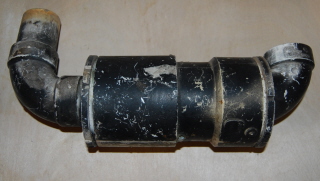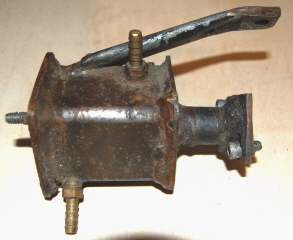Turbo Charger: What is it?
We should define what that means. A turbocharger is a fan that is rotated by the exhaust pressure. It is actually an exhaust turbine, that is why they call it a turbo charger. It is a turbine on the exhaust. The turbine that runs off of the exhaust spins a compressor called an impeller, and the impeller compresses the air into the intake manifold.
The intake pressure then causes the amount of air fuel to go into the engine to be higher and the resulting higher air fuel mixture, which means more power per cubic inch.
Turbo Charging Pressure Limits
There is a limit to how much pressure you can actually stuff into an engine. I have seen that some racers will stuff 24-PSI which is basically close to being double atmospheric into an engine, but typically the most that you can get out of a turbo charger is going to be around 5 psi to 8 psi.
Turbo Charging Limits On Smaller Engines
The other thing too is that especially on a small engine like a 5 horsepower or even like a 10 horsepower you are going to taxed. You are going to be asking a lot of that little engine to get that impeller to spin up and go; so you may not get a whole lot pressure out of it to start. Additionally you are going to have some serious turbo lag to start with.
I have considered some ways to enhance a particular turbo which would be to put an after-burner of sorts where you would crank up the boost on it artificially, but now you are talking about it getting hyper complex.
Turbo Charging System Basics: Oil Pressure Is Very Important
The basics though of the turbo charged system is that you need to have an oiling system or a pressurized oil system. These turbo chargers typically use oil pressure to keep the bearings lubricated.
There are a couple of reasons for that:
– First of all it draws out the heat from the turbo charger and puts it into the oil.
– Secondly it obviously offers a film of oil for the the turbine bearing to run in.
Some turbines do not have roller bearings it is just an oil film that they run on. If the oil film is missing or gone then the turbo charger will seize up and stop functioning.
Weight Considerations With Turbo Charging and Extra Stuff Required
So it is very important that you have an oil pressure system or a turbo charger if you are going to hook one up. So that means an added a pump of some sort.
And it is not just a simple, “ Let’s bolt on the electric pump” because now you start bolting on electric pump, then you have to add a battery and you are adding weight.
The whole idea behind a turbo charger is that you are enhancing performance of an engine. You are basically taking an engine that has 5 horsepower and you are making it so that it is 8 horsepower. Well, the tradeoff is how much weight are you going to have byadd to get this amount of horsepower.
It is cool to have a turbo bolted on there, defintely cool to have a turbo charged wine. But is the added weight actually giving you any benefit? That is the issue when you start to deal with bolt on horsepower like a turbo charger or a super charger.
Turbo Charger Size: Small Is Better
But what we are talking about here though is the turbo charger, and how to get it to work. You are going to need a very small turbo charger, the smallest you can get. There are some motor cycles, 4 cylinder motorcycles that have turbo chargers on them. That would be the kind that I would suggest you get.
Now you are going to notice one thing about dealing with these turbo chargers that they weigh about 15-20 lb. just by themselves. If you weigh a standard of 5 horsepower engine, it weighs about 40-50 lb.
The CentrifugalSupercharger Manual is free with the purchase of the plans. In it are details on how to mount, what tricks to use when supercharging engines.These are some related articles on Super Charging and are well worth the read:
| Basic Principles in SuperCharging: A Go Kart With More Bolt On Power |
| Getting More Umph Out of Your SuperCharger Set Up |
Weight Considerations: Why Are You Turbo Charging The Go Kart?
So you actually added a lot of weight just for a turbo. So if you are considering using a turbo charger for adding power to save weight out of your package, that is not going to be your prime objective. It is going to be more a show piece. It is going to be a lot of headaches, because of the oil system that you are going to be dealing with.
I would suggest that you would go the easier way which would be a belt driven system super charger, which would give you better over all performance all around.
Heat Considerations: Heat Kills Power!
The turbo charger as we have said before, uses the exhaust to turn the turbine to turn the compressor. There is heat added from the exhaust pipe. The heat is going to get into the intake side. So you need to be aware that. You may get some detrimental performance because of the heat.
As far as whenever you compress air there is a relationship between the pressure and temperature and the formula is CP=MRT or another way thatmost of us look at it as :
pressure x volume = mass x constant x temperature.
If you notice that if you multiply pressure x volume you will get a relationship between the mass temperature.
You really could say PV=(relatively speaking) temperature.
So as long as your mass has not changed a whole lot. Your mass is going to increase a little bit. So those two are multiplied together.
So the bottom line though is that when you start increasing your pressure (which you do if you do with a supercharger) and you start reducing your volume your temperature is going to increase. Your volume for all intensive purposes stays the same and you start increasing your pressure. Your temperature will go up.
Keeping that in mind, that is what a turbocharger does. You have a fixed volume in your engine (that is not changing), but your pressure coming in is. So your temperature is going to crank up on the intake charge.
Removing Heat: Intercoolers, Water Injection And The Science Behind It All
You can say OK so what. Well, as the temperature increases then your volume (the amount of air that comes into the engine) decreases. So whatyou want to do is take away some of that temperature so that your volume increases too. It is called intercooler.
An intercooler strips off the heat and allows a higher density of air to be compressed into the engine. What typically happens is that, on a turbocharger, you may end up cranking in higher pressure but the volume of air that is going in to the engine maybe so hot that it loses its density that it needs to have to come into the engine. And as a result you do not have a very good power increase.
 You can use water injection as well. What that does is you spray water into the hot air that comes off the turbo and it actually causes the heat from the air to go into the water and then the water strips off the heat. The air-water-fuel mixture then goes into the engine and gets converted into steam. (It is not really useful steam.) It just gets sucked into the combustion process. It also from what I understand helps enhance the combustion process. You also may get a little bit better fuel consumption.
You can use water injection as well. What that does is you spray water into the hot air that comes off the turbo and it actually causes the heat from the air to go into the water and then the water strips off the heat. The air-water-fuel mixture then goes into the engine and gets converted into steam. (It is not really useful steam.) It just gets sucked into the combustion process. It also from what I understand helps enhance the combustion process. You also may get a little bit better fuel consumption.
Fuel Systems: How Do You Get That Fuel Mixture Stuffed Into The Engine?
Another thing to keep in mind is most people when they hook up a turbo charger there are two ways to introduced fuel into the system. Either use a fuel injector or a carburetor.
But most people steer away from carburetors just because they think they are difficult to deal with. The reality of it is though a carburetor is very efficient design. It is the best design you can come up with to get the air and the fuel mixed together for very low cost.
If you look at a stochiemetric chart and the relationship between the air mass and the fuel that comes through and relate that to how a carburetor works. It has a good approximation across the power curve using a carburetor especially for a small engine.
So what you can do though, and I have seen people do this, they hook their turbo chargers up and then they suck the air through the turbo charger. That is the old way of doing it. Before there were fuel injectors they would suck air through the turbo charger.
Well the problem is you must have a very tight system and on a low budget it is very difficult to make a very tight air system. So the better option would be, on these smaller engines, to stuff the air into the carburetor. It is very possible and also it does not require expensive modifications to your engine.
Turbo Charging Fuel Systems For Briggs and Tecumseh Engines
For instance on Briggs and Stratton all you have to do is put a special fuel cap on the gas tank and you are ready to go. The pressurized hose line and a special fuel cap, and hook your turbo up and stuff it into the carburetor and away it goes!
Now it is not just that easy on a Briggs.
If I were to tell you the best engine for a turbocharger would be a Tecumseh because it has a very pressurizer friendly carburetor. In other words you can modify it to handle pressurization a lot easier in some cases, not all cases though, than the Briggs.
On the Briggs I have had some difficulties. I almost had to pull my hair out trying to get them to work with a supercharger because the way carburetor works. They changed somethings and I was overheating the engine a bit and so on.
There are some tricks to get to understand how a carburetor works and what the pressurization is actually doing.
In the go kart manual (which I do supply with our plans for free!) I talk in depth and detail about how to pressurize your carburetor. The most important part of the process when you are turbocharging or supercharging is to set the carburetor up so that it is doing it’s job.
If you are sucking air through your turbo then that is one way, but you have to have a very tight system or you will never be able to get it to start. If you are stuffing air through your carburetor, then you need to have a carberater-pressurized sufficiently.
Mounting The Turbo Charger: A Big Headache,
Be Prepared To Support It
There are a couple of things, when you mount this turbocharger: you are going to have to make an exhaust manifold which is custom.
One of the things you are going to need to understand when you start throwing on the exhaust manifolds and bolting on stuff the aluminum engines, is that the conventional bolting methods and not going to work. It is not going to be strong enough. You are going to have to enhance the strength of the system by using some bracketry, which is absolutely external to the engine or it is going to be part of your gocart frame and you can not trust your gokart frame to not flex.
What you want is a system that is integral (the same) with your motor. So you are going to have to have some sort of bracket.
Typically if you look at go-carters racing go-karters they have some sort of bracket that comes off the head bolt, and that is why on my go cart supercharger I actually bolt it onto the head. Off of that you can bolt on brackets that hold the intake manifold and they hold the exhaust manifolds.
Examples of Bracketry And Manifold Designs
 What I did in my first gokart if you look at some of the pictures of it, I actually adapted it from a Briggs and Stratton engine so it ran with a Tecumseh carburetor. To get that to occur I had a manifold and then I had a special bracket that would hold the carburetor from moving. I would weld it right on to it.
What I did in my first gokart if you look at some of the pictures of it, I actually adapted it from a Briggs and Stratton engine so it ran with a Tecumseh carburetor. To get that to occur I had a manifold and then I had a special bracket that would hold the carburetor from moving. I would weld it right on to it.
As far as turbo charging you are going to have to have a custom exhaust manifold that you are going to have to make yourself. There is nothing after market out there. You are going to have to have a little head knowledge about how to work with grinders and welders. You are going to be doing a lot of hand grinding and fitting to get this thing to work.
CAD Program, Laser Technology And Your Turbo System
One of the nice things about technology is that we have today drawing programs. Because if you are pretty good at drawing stuff you can draw it in a CAD program and then send the DXF off to a laser facility and they will be able to cut the steel. I would recommend that you cut it at least a ¼ in. thick or a least an 1/8 in thick.
The basic design of would include tube, one of those smooth bored tubes. Do not use a cast iron tube it is not going weld very well.
What you are going to need is some sort of tube that is steel and has a smooth bore or on the inside and then you weld your flange to it. Weld the flange to the hold bracket from moving and then adapt that to your turbo to fit onto this bracket you have designed. The turbo is going to be heavy itself, so you need to have that bracketed to it so it do not fall or twist or rip that bracket right off. You are going to have to that mounted somewhere.
Mounting Bracketry, Oil Pumps And The Need To Pressurize The Oil.
You can mount it on the frame or mount it off the head some how.
You can see how all this bracketry is going to start increasing weight, but if you are really into this, just keep going with it. You are going to have to weld it to the bracket and then you are going to have to have a pump of some sort.
You can either use an electric pump that sucks oil out of your engine crank case, or you can hook up a mechanical pump that runs off of a belt drive.
Now I have yet to find a mechanical pump that actually runs off of a belt drive system, so I can not really recommend that. I know I have seen on the internet people have made turbo chargers.
I am not really quite sure how they are pressurizing these things, but you are going to need to get an oil pressure system. If you notice they do have some thing that is running oil into these turbo chargers. In fact when they start up, there is oil smoke everywhere.
Things To Consider, When Turbo Charging Your Go kart Engine
So the bottom line is there are a couple things to remember when you are hooking up a turbo charger system:
-You are going to need an oil pressurizer system.
-You are going to need a fuel relay system.
How are you going to get the fuel into the engine? To me there is two ways:
-You can suck the fuel through the turbo charger
-Or you can stuff air into the carburetor.
-You are going to need a bracket system that you are going to put together. Is this going to be robust enough to keep the turbo from twisting and ripping off the engine itself?


